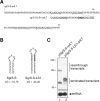Role of the terminator hairpin in the biogenesis of functional Hfq-binding sRNAs
- PMID: 28606943
- PMCID: PMC5558911
- DOI: 10.1261/rna.060756.117
Role of the terminator hairpin in the biogenesis of functional Hfq-binding sRNAs
Abstract
Rho-independent transcription terminators of the genes encoding bacterial Hfq-binding sRNAs possess a set of seven or more T residues at the 3' end, as noted in previous studies. Here, we have studied the role of the terminator hairpin in the biogenesis of sRNAs focusing on SgrS and RyhB in Escherichia coli. We constructed variant sRNA genes in which the GC-rich inverted repeat sequences are extended to stabilize the terminator hairpins. We demonstrate that the extension of the hairpin stem leads to generation of heterogeneous transcripts in which the poly(U) tail is shortened. The transcripts with shortened poly(U) tails no longer bind to Hfq and lose the ability to repress the target mRNAs. The shortened transcripts are generated in an in vitro transcription system with purified RNA polymerase, indicating that the generation of shortened transcripts is caused by premature transcription termination. We conclude that the terminator structure of sRNA genes is optimized to generate functional sRNAs. Thus, the Rho-independent terminators of sRNA genes possess two common features: a long T residue stretch that is a prerequisite for generation of functional sRNAs and a moderate strength of hairpin structure that ensures the termination at the seventh or longer position within the consecutive T stretch. The modulation of the termination position at the Rho-independent terminators is critical for biosynthesis of functional sRNAs.
Keywords: Hfq; RNA hairpin; Rho-independent terminator; bacterial sRNA; premature termination.
© 2017 Morita et al.; Published by Cold Spring Harbor Laboratory Press for the RNA Society.
Figures







Similar articles
-
Regulation of Transcription Termination of Small RNAs and by Small RNAs: Molecular Mechanisms and Biological Functions.Front Cell Infect Microbiol. 2019 Jun 12;9:201. doi: 10.3389/fcimb.2019.00201. eCollection 2019. Front Cell Infect Microbiol. 2019. PMID: 31249814 Free PMC article. Review.
-
Insights into transcription termination of Hfq-binding sRNAs of Escherichia coli and characterization of readthrough products.RNA. 2015 Aug;21(8):1490-501. doi: 10.1261/rna.051870.115. Epub 2015 Jun 23. RNA. 2015. PMID: 26106215 Free PMC article.
-
The functional Hfq-binding module of bacterial sRNAs consists of a double or single hairpin preceded by a U-rich sequence and followed by a 3' poly(U) tail.RNA. 2012 May;18(5):1062-74. doi: 10.1261/rna.031575.111. Epub 2012 Mar 27. RNA. 2012. PMID: 22454537 Free PMC article.
-
PolyU tail of rho-independent terminator of bacterial small RNAs is essential for Hfq action.Proc Natl Acad Sci U S A. 2011 Aug 9;108(32):13059-64. doi: 10.1073/pnas.1107050108. Epub 2011 Jul 25. Proc Natl Acad Sci U S A. 2011. PMID: 21788484 Free PMC article.
-
The interplay of Hfq, poly(A) polymerase I and exoribonucleases at the 3' ends of RNAs resulting from Rho-independent termination: A tentative model.RNA Biol. 2013 Apr;10(4):602-9. doi: 10.4161/rna.23664. Epub 2013 Feb 7. RNA Biol. 2013. PMID: 23392248 Free PMC article. Review.
Cited by
-
The read-through transcription-mediated autoactivation circuit for virulence regulator expression drives robust type III secretion system 2 expression in Vibrio parahaemolyticus.PLoS Pathog. 2024 Mar 27;20(3):e1012094. doi: 10.1371/journal.ppat.1012094. eCollection 2024 Mar. PLoS Pathog. 2024. PMID: 38536895 Free PMC article.
-
Novel P335-like Phage Resistance Arises from Deletion within Putative Autolysin yccB in Lactococcus lactis.Viruses. 2023 Oct 31;15(11):2193. doi: 10.3390/v15112193. Viruses. 2023. PMID: 38005870 Free PMC article.
-
Identification of Attenuators of Transcriptional Termination: Implications for RNA Regulation in Escherichia coli.mBio. 2022 Dec 20;13(6):e0237122. doi: 10.1128/mbio.02371-22. Epub 2022 Oct 13. mBio. 2022. PMID: 36226957 Free PMC article.
-
Regulation of Transcription Termination of Small RNAs and by Small RNAs: Molecular Mechanisms and Biological Functions.Front Cell Infect Microbiol. 2019 Jun 12;9:201. doi: 10.3389/fcimb.2019.00201. eCollection 2019. Front Cell Infect Microbiol. 2019. PMID: 31249814 Free PMC article. Review.
-
What goes up must come down: off switches for regulatory RNAs.Genes Dev. 2024 Aug 20;38(13-14):597-613. doi: 10.1101/gad.351934.124. Genes Dev. 2024. PMID: 39111824 Free PMC article. Review.
References
-
- Aiba H, Adhya S, de Crombrugghe B. 1981. Evidence for two functional gal promoters in intact Escherichia coli cells. J Biol Chem 256: 11905–11910. - PubMed
-
- Argaman L, Hershberg R, Vogel J, Bejerano G, Wagner EG, Margalit H, Altuvia S. 2001. Novel small RNA-encoding genes in the intergenic regions of Escherichia coli. Curr Biol 11: 941–950. - PubMed
-
- Cheng SW, Lynch EC, Leason KR, Court DL, Shapiro BA, Friedman DI. 1991. Functional importance of sequence in the stem-loop of a transcription terminator. Science 254: 1205–1207. - PubMed
-
- d'Aubenton Carafa Y, Brody E, Thermes C. 1990. Prediction of rho-independent Escherichia coli transcription terminators. A statistical analysis of their RNA stem-loop structures. J Mol Biol 216: 835–858. - PubMed
MeSH terms
Substances
LinkOut - more resources
Full Text Sources
Other Literature Sources
Molecular Biology Databases
Miscellaneous
